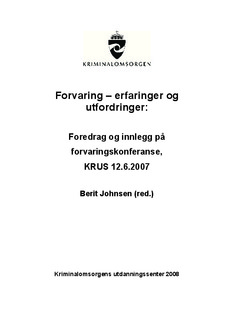Forvaring - erfaringer og utfordringer
Book
Permanent lenke
http://hdl.handle.net/11250/160592Utgivelsesdato
2008Metadata
Vis full innførselSamlinger
- KRUS - Publikasjoner [99]
Sammendrag
This publication is a result of a conference about preventive detention that took
place at The Correctional Service of Norway Staff Academy June 12, 2007. The
purpose of the conference was to gather the different services that are involved in
the criminal proceedings of preventive detention – the police, the prosecuting
authority, the courts, the experts on forensic psychiatry, the lawyers, the
correctional services and those who are convicted to preventive detention – in
order to create a dialogue. Research over the years the law of preventive detention
has existed, has revealed a need for such a dialogue. Nearly 150 persons from
different services participated at the conference, which shows that there is a great
interest in the subject.
The title “Preventive detention – experiences and challenges” reflects that the
papers presented at the conference and which are published in this report, focus on
the past as well as the future. The report presents the experiences and challenges
of preventive detention from different stands: the political, the forensic psychiatry,
the courts, the prisons, the probation service, the prosecuting authority, the
lawyers and the convicted.
The new law on preventive detention took effect on January 1, 2002. The purpose
of the law is to protect the public from offenders that are considered to be
dangerous. In principle, there is no upper time limit to a preventive detention
sentence. However, when the court convicts a person to preventive detention it
has to set a time frame, which cannot exceed 21 years. The court can prolong the
sentence, if it considers the convicted person to be still too dangerous to release.
